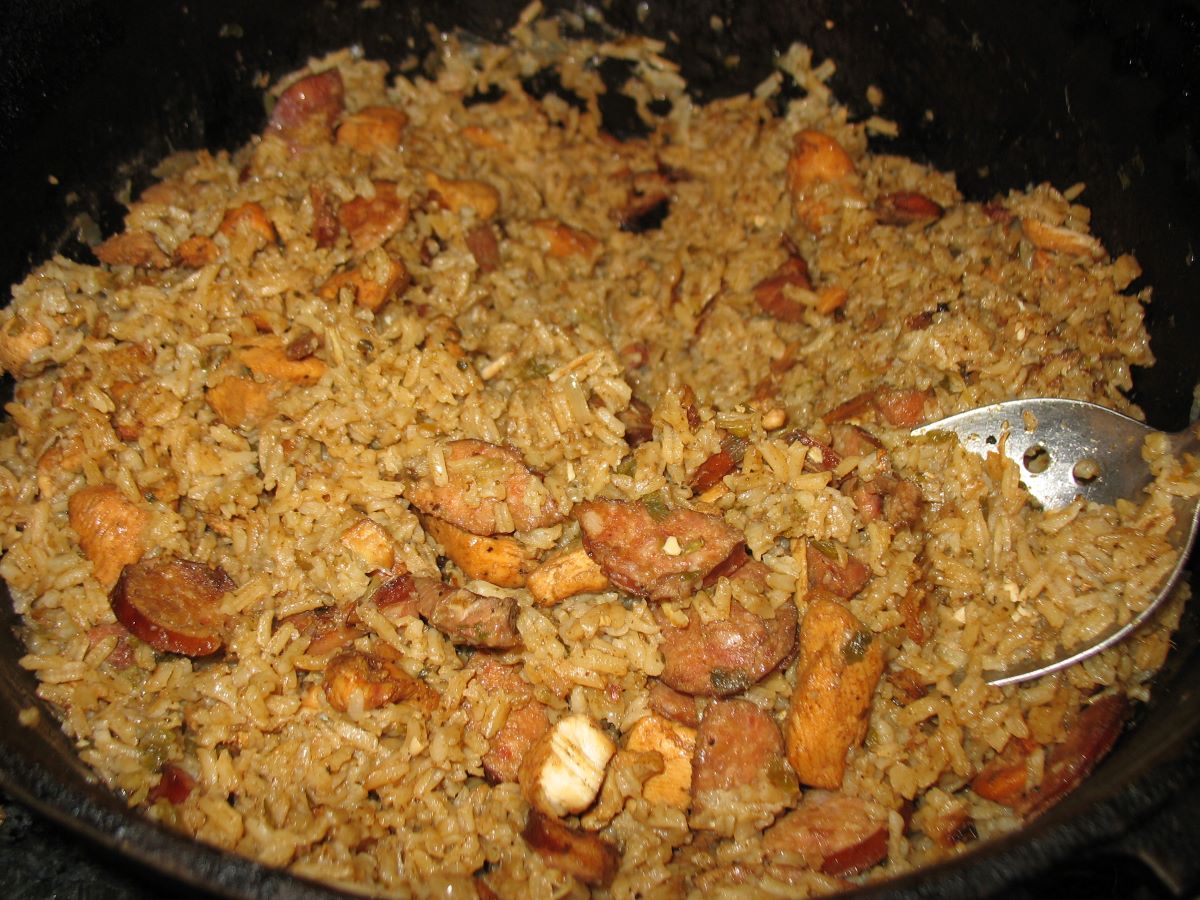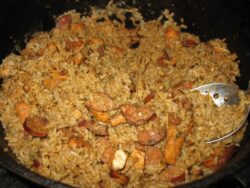Jambalaya
A rice-based mixture of meats and/or seafood along with vegetables, herbs, and spices, jambalaya is a representative dish of South Louisiana.

Photo by Naviniea, Wikimedia Commons
Chicken and sausage jambalaya in a cast iron skillet.
A rice-based mixture of meats and/or seafood along with vegetables, herbs, and spices, jambalaya is a representative dish of South Louisiana, especially the parishes of Acadiana. Jambalaya, like its ancestral cousins, the Spanish paella and the West African jollof, is versatile in preparation and composition.
Like many of the state’s heritage dishes, jambalaya’s beginnings are historically uncertain. Debate persists about the origins of the dish’s name. The most-cited etymology credits a combination of jambon, the French word for ham, with ay or yaya, words in some West African languages for grasses and grains. Another theory similarly claims a fusion of the Spanish words jamón (ham) and paella. Other scholars posit the name is related to jambalaia, a chicken, rice, and vegetable stew eaten in the Provençal region of France. At least one culinary historian has pointed out that jambalaya might be a cognate of the English word “jumble,” which, according to the Oxford English Dictionary, is an onomatopoeia dating back to the sixteenth century.
The earliest found recipe for jambalaya occurs in the Gulf City Cook Book, released by the St. Francis Street Methodist Episcopal Church Society of Mobile, Alabama, in 1878. The recipe, spelled “Jam Bolaya,” incorporates chicken and oysters.
The earliest Louisiana cookbook to feature a jambalaya recipe is Lafcadio Hearn’s La Cuisine Creole, published in 1885. The recipe for “Jambalaya of fowls and rice” reads:
Cut up and stew a fowl; when half done, add a cup of raw rice, a slice of ham minced, and pepper and salt; let all cook together until the rice swells and absorbs all the gravy of the stewed chicken, but it must not be allowed to get hard or dry. Serve in a deep dish. Southern children are very fond of this; it is said to be an Indian dish, and very wholesome as well as palatable; it can be made with many things.
Jambalaya’s preparation traditionally begins with browning meat, especially sausage, in fat. Like many Cajun and Creole dishes, the “Holy Trinity” of onion, celery, and bell pepper alongside garlic is then added to the pot. Stock, other vegetables (like green onions), and spices are folded in and simmered before adding chicken or seafood. Raw or cooked rice, added last, fortifies the dish.
New Orleans-style Creole jambalayas are sometimes referred to as “red” for their inclusion of tomatoes, fresh or canned. Cajun cooks generally renounce the use of tomatoes in their jambalayas, which are thus classified as “brown.”
Though found in restaurants throughout Louisiana and the Gulf Coast, jambalaya is most often a home-cooked meal, able to be produced in large quantities to feed a crowd. Jambalaya is also popular at festivals, such as the annual Blackpot Festival and Cookoff in Lafayette. The Gonzales Jambalaya Festival, held each May since 1968, features several cooking competitions, including the crowning of a Jambalaya World Champion and a contest where cooks prepare the dish in the “World’s Smallest Jambalaya Pot.”
Jambalaya might be best known for being popularized by country music singer Hank Williams in his iconic 1952 song “Jambalaya (On the Bayou).” The refrain of that song, which has been covered by dozens of artists (from Fats Domino to Jerry Lee Lewis, Chuck Berry to the Carpenters), celebrates “jambalaya and a crawfish pie, and a filé gumbo” and has spread the gospel of Louisiana cooking across the globe.
